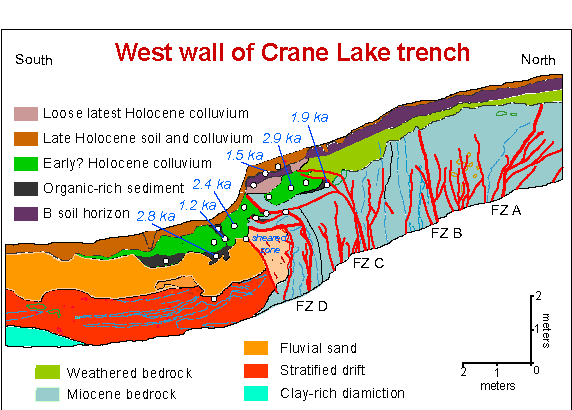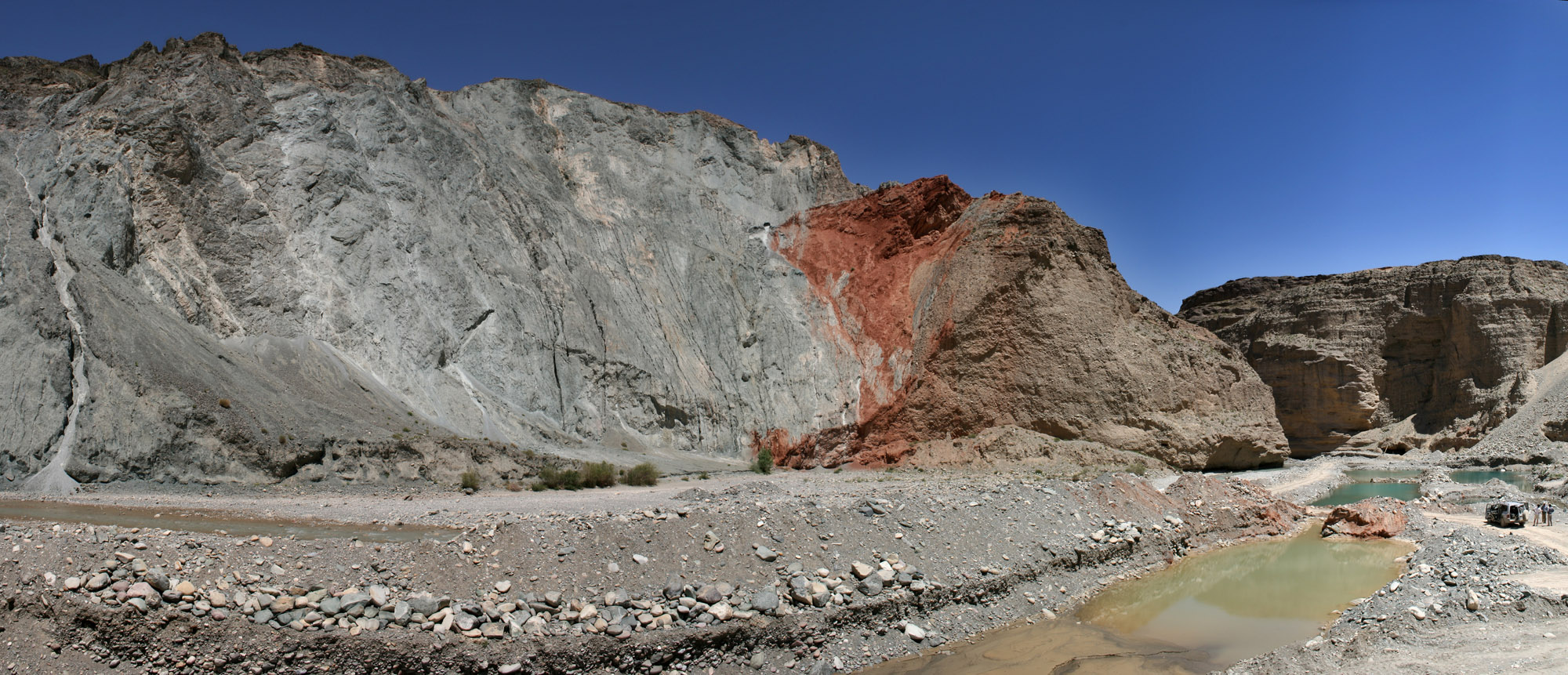|
1139 Ganja Earthquake
The 1139 Ganja earthquake was one of the worst seismic events in history. It affected the Seljuk Empire and the Kingdom of Georgia, in modern-day Azerbaijan and Georgia (country), Georgia. The earthquake had an estimated magnitude of 7.7 , 7.5 and 7.0–7.3 . A disputed death toll of 230,000–300,000 resulted from this event, making it one of the deadliest earthquakes ever recorded. Tectonic setting Azerbaijan, Armenia and Georgia are located in an area of high seismic activity as both countries are situated in the collision zone between the Eurasian plate, Eurasian and Arabian plates. The collision zone consists of an accreted island arc that collided after the closure of the Tethys Ocean, continental blocks, and sediments from the Mesozoic and Tertiary period, Tertiary eras. The area is separated into three geographical regions; Lesser Caucasus, Kura (South Caucasus river), Kura Basin and Greater Caucasus. Seismic activity in the Lesser Caucasus is typically associated with st ... [...More Info...] [...Related Items...] OR: [Wikipedia] [Google] [Baidu] |
Seljuk Empire
The Seljuk Empire, or the Great Seljuk Empire, was a High Middle Ages, high medieval, culturally Turco-Persian tradition, Turco-Persian, Sunni Islam, Sunni Muslim empire, established and ruled by the Qiniq (tribe), Qïnïq branch of Oghuz Turks. The empire spanned a total area of from Anatolia and the Levant in the west to the Hindu Kush in the east, and from Central Asia in the north to the Persian Gulf in the south, and it spanned the time period 1037–1308, though Seljuk rule beyond the Anatolian peninsula ended in 1194. The Seljuk Empire was founded in 1037 by Tughril (990–1063) and his brother Chaghri Beg, Chaghri (989–1060), both of whom co-ruled over its territories; there are indications that the Seljuk leadership otherwise functioned as a triumvirate and thus included Seljuk dynasty, Musa Yabghu, the uncle of the aforementioned two. During the formative phase of the empire, the Seljuks first advanced from their original homelands near the Aral Sea into Greater Kho ... [...More Info...] [...Related Items...] OR: [Wikipedia] [Google] [Baidu] |
Mercalli Intensity Scale
The Modified Mercalli intensity scale (MM, MMI, or MCS) measures the effects of an earthquake at a given location. This is in contrast with the seismic magnitude usually reported for an earthquake. Magnitude scales measure the inherent force or strength of an earthquake — an event occurring at greater or lesser depth. (The "" scale is widely used.) The MMI scale measures intensity of shaking, at any particular location, on the surface. It was developed from Giuseppe Mercalli's Mercalli intensity scale of 1902. While shaking experienced at the surface is caused by the seismic energy released by an earthquake, earthquakes differ in how much of their energy is radiated as seismic waves. They also differ in the depth at which they occur; deeper earthquakes have less interaction with the surface, their energy is spread throughout a larger volume, and the energy reaching the surface is spread across a larger area. Shaking intensity is localised. It generally diminishes with dist ... [...More Info...] [...Related Items...] OR: [Wikipedia] [Google] [Baidu] |
Kingdom Of Syunik
Kingdom of Syunik (), also known as the Kingdom of Baghk and sometimes as the Kingdom of Kapan, was a medieval dependent Armenian kingdomArmenia and Iran // "''In 1162, eastern Armenia was attacked by the atabeg Īldegoz of Azerbaijan. In 1170, with a new invasion, the Armenian Kingdom of Siunikʿ was terminated.''"Armenia // "''The Byzantine conquest was short-lived ... [...More Info...] [...Related Items...] OR: [Wikipedia] [Google] [Baidu] |
Bible
The Bible is a collection of religious texts that are central to Christianity and Judaism, and esteemed in other Abrahamic religions such as Islam. The Bible is an anthology (a compilation of texts of a variety of forms) originally written in Hebrew, Aramaic, and Koine Greek. The texts include instructions, stories, poetry, prophecies, and other genres. The collection of materials accepted as part of the Bible by a particular religious tradition or community is called a biblical canon. Believers generally consider it to be a product of divine inspiration, but the way they understand what that means and interpret the text varies. The religious texts were compiled by different religious communities into various official collections. The earliest contained the first five books of the Bible, called the Torah in Hebrew and the Pentateuch (meaning 'five books') in Greek. The second-oldest part was a collection of narrative histories and prophecies (the Nevi'im). The third co ... [...More Info...] [...Related Items...] OR: [Wikipedia] [Google] [Baidu] |
Psalm 103
Psalm 103 is the 103rd psalm of the Book of Psalms, beginning in English in the King James Version: "Bless the , O my soul". The Book of Psalms is part of the third section of the Tanakh, Hebrew Bible, and a book of the Christianity, Christian Old Testament. In Latin, it is known as "Benedic anima mea Domino". The psalm is a Psalms#Primary types, hymn psalm. In the slightly different numbering system used in the Greek Septuagint and Latin Vulgate translations of the Bible, this psalm is Psalm 102. The first verse (the sub-heading in most English translations) attributes the psalm to King David. The psalm forms a regular part of Jewish history, Jewish, Catholic Church, Catholic, Lutheranism, Lutheran, Anglicanism, Anglican and other Protestant liturgies. The psalm has been paraphrased in hymns, and has often been set to music. Background and themes Baptist preacher and biblical commentator Charles Spurgeon suggests that the psalm was written in David's later life, as seen by th ... [...More Info...] [...Related Items...] OR: [Wikipedia] [Google] [Baidu] |
Job 9
Job 9 is the ninth chapter of the Book of Job in the Hebrew Bible or the Old Testament of the Christian Bible.Holman Illustrated Bible Handbook. Holman Bible Publishers, Nashville, Tennessee. 2012. The book is anonymous; most scholars believe it was written around 6th century BCE. This chapter records the speech of Job, which belongs to the Dialogue section of the book, comprising Job 3:1– 31:40. Text The original text is written in Hebrew language. This chapter is divided into 35 verses. Textual witnesses Some early manuscripts containing the text of this chapter in Hebrew are of the Masoretic Text, which includes the Aleppo Codex (10th century), and Codex Leningradensis (1008). Fragments containing parts of this chapter in Hebrew were found among the Dead Sea Scrolls including 4Q100 (4QJob; 50–1 BCE) with extant verse 27. There is also a translation into Koine Greek known as the Septuagint, made in the last few centuries BC; some extant ancient manuscripts of this versi ... [...More Info...] [...Related Items...] OR: [Wikipedia] [Google] [Baidu] |
Armenians
Armenians (, ) are an ethnic group indigenous to the Armenian highlands of West Asia.Robert Hewsen, Hewsen, Robert H. "The Geography of Armenia" in ''The Armenian People From Ancient to Modern Times Volume I: The Dynastic Periods: From Antiquity to the Fourteenth Century''. Richard G. Hovannisian (ed.) New York: St. Martin's Press, 1997, pp. 1–17 Armenians constitute the main demographic group in Armenia and constituted the main population of the breakaway Republic of Artsakh until their Flight of Nagorno-Karabakh Armenians, subsequent flight due to the 2023 Azerbaijani offensive in Nagorno-Karabakh, 2023 Azerbaijani offensive. There is a large Armenian diaspora, diaspora of around five million people of Armenian ancestry living outside the Republic of Armenia. The largest Armenian populations exist in Armenians in Russia, Russia, the Armenian Americans, United States, Armenians in France, France, Armenians in Georgia, Georgia, Iranian Armenians, Iran, Armenians in Germany, ... [...More Info...] [...Related Items...] OR: [Wikipedia] [Google] [Baidu] |
Mkhitar Gosh
Mkhitar Gosh ( 1130–1213) was an Armenian scholar, writer, public figure, thinker, and priest. He was one of the representatives of the Armenian Renaissance. Biography He was born in the city of Gandzak. He got his early education from public institutions. When he reached his adolescence he decided to dedicate his life to the church. To learn theology more thoroughly, Gosh traveled to Cilicia, to the Black Mountains (), and studied orthodox theology under the local priests. Upon his return, he, along with the princes' Zakare and Ivane Zakarian financial help, built the church of Getik. He wrote a code of laws including civil and canon law that was used in both Greater Armenia and Cilicia. It was also used in Poland, by order of king Sigismund the Old, as the law under which the Armenians of Lviv and Kamianets-Podilskyi lived from 1519 until the region fell under Austrian rule in 1772. He also wrote several popular fables. He founded the monastery of Nor Getik, where he w ... [...More Info...] [...Related Items...] OR: [Wikipedia] [Google] [Baidu] |
1931 Zangezur Earthquake
The 1931 Zangezur earthquake occurred on April 27 at with a moment magnitude of 6.5. The earthquake was located in the Zangezur Mountains near the boundary between southwestern Armenia and Azerbaijan's exclave, the Nakhichivan Autonomous Republic. Both territories were part of the Soviet Union at that time. Tectonic setting The Pambak-Sevan-Sunik Fault extends in the NW–SE direction. The fault can be traced continuously for 400 km and consists of four major segments. The 1931 Zangezur earthquake was located in the area of the Sunik-Zanghezour segment, which is about 120 km long. The fault was also the source of the magnitude 7.5+ 1139 Ganja earthquake; the largest and most destructive seismic event in the Caucasus. Earthquake The earthquake was located near the border between the Syunik Province of Armenia (''Zangezur'' is an alternative name for the region of Syunik Province) and the Nakhichivan Autonomous Republic of Azerbaijan. Up to 2,890 were reported dead. In A ... [...More Info...] [...Related Items...] OR: [Wikipedia] [Google] [Baidu] |
Paleoseismology
Paleoseismology is the study of ancient earthquakes using geologic evidence, such as geologic sediments and rocks. It is used to supplement seismic monitoring to calculate seismic hazard. Paleoseismology is usually restricted to geologic regimes that have undergone continuous sediment creation for the last few thousand years, such as swamps, lakes, river beds and shorelines. Methodology Procedure Paleoseismology studies start with finding an active fault. The definition of an active fault can vary, but it is usually based on having tectonically deformed quaternary-age materials that can potentially cause earthquakes. Satellite imaging with high resolution is often used to find such faults, but because of its resolution limitations, there are also other methods such as ground-penetrating radar (GPR), aeromagnetic surveys, and seismic reflection surveys. Faults can be dated in absolute terms using radiocarbon dating. Paleoseismic evidence Evidence of paleoearthquakes ... [...More Info...] [...Related Items...] OR: [Wikipedia] [Google] [Baidu] |
Thrust Fault
A thrust fault is a break in the Earth's crust, across which older rocks are pushed above younger rocks. Thrust geometry and nomenclature Reverse faults A thrust fault is a type of reverse fault that has a dip of 45 degrees or less. If the angle of the fault plane is lower (often less than 15 degrees from the horizontal) and the displacement of the overlying block is large (often in the kilometer range) the fault is called an ''overthrust'' or ''overthrust fault''. Erosion can remove part of the overlying block, creating a ''fenster'' (or ''window'') – when the underlying block is exposed only in a relatively small area. When erosion removes most of the overlying block, leaving island-like remnants resting on the lower block, the remnants are called ''klippen'' (singular '' klippe''). Blind thrust faults If the fault plane terminates before it reaches the Earth's surface, it is called a ''blind thrust'' fault. Because of the lack of surface evidence, blind thrust fa ... [...More Info...] [...Related Items...] OR: [Wikipedia] [Google] [Baidu] |






